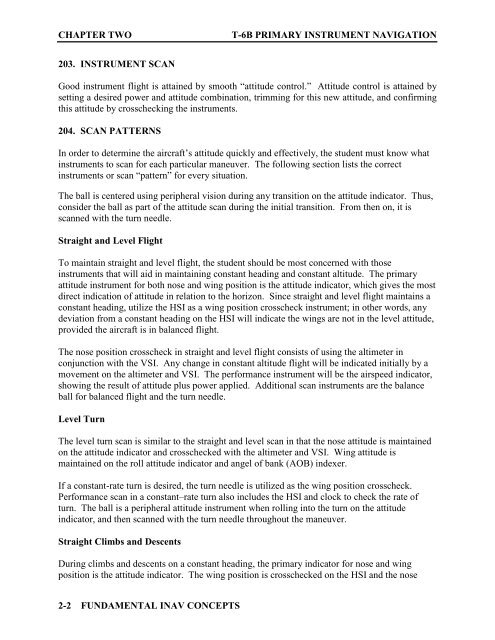Flight Training Instruction - Cnatra - U.S. Navy
Flight Training Instruction - Cnatra - U.S. Navy
Flight Training Instruction - Cnatra - U.S. Navy
Create successful ePaper yourself
Turn your PDF publications into a flip-book with our unique Google optimized e-Paper software.
CHAPTER TWO T-6B PRIMARY INSTRUMENT NAVIGATION<br />
203. INSTRUMENT SCAN<br />
Good instrument flight is attained by smooth “attitude control.” Attitude control is attained by<br />
setting a desired power and attitude combination, trimming for this new attitude, and confirming<br />
this attitude by crosschecking the instruments.<br />
204. SCAN PATTERNS<br />
In order to determine the aircraft’s attitude quickly and effectively, the student must know what<br />
instruments to scan for each particular maneuver. The following section lists the correct<br />
instruments or scan “pattern” for every situation.<br />
The ball is centered using peripheral vision during any transition on the attitude indicator. Thus,<br />
consider the ball as part of the attitude scan during the initial transition. From then on, it is<br />
scanned with the turn needle.<br />
Straight and Level <strong>Flight</strong><br />
To maintain straight and level flight, the student should be most concerned with those<br />
instruments that will aid in maintaining constant heading and constant altitude. The primary<br />
attitude instrument for both nose and wing position is the attitude indicator, which gives the most<br />
direct indication of attitude in relation to the horizon. Since straight and level flight maintains a<br />
constant heading, utilize the HSI as a wing position crosscheck instrument; in other words, any<br />
deviation from a constant heading on the HSI will indicate the wings are not in the level attitude,<br />
provided the aircraft is in balanced flight.<br />
The nose position crosscheck in straight and level flight consists of using the altimeter in<br />
conjunction with the VSI. Any change in constant altitude flight will be indicated initially by a<br />
movement on the altimeter and VSI. The performance instrument will be the airspeed indicator,<br />
showing the result of attitude plus power applied. Additional scan instruments are the balance<br />
ball for balanced flight and the turn needle.<br />
Level Turn<br />
The level turn scan is similar to the straight and level scan in that the nose attitude is maintained<br />
on the attitude indicator and crosschecked with the altimeter and VSI. Wing attitude is<br />
maintained on the roll attitude indicator and angel of bank (AOB) indexer.<br />
If a constant-rate turn is desired, the turn needle is utilized as the wing position crosscheck.<br />
Performance scan in a constant–rate turn also includes the HSI and clock to check the rate of<br />
turn. The ball is a peripheral attitude instrument when rolling into the turn on the attitude<br />
indicator, and then scanned with the turn needle throughout the maneuver.<br />
Straight Climbs and Descents<br />
During climbs and descents on a constant heading, the primary indicator for nose and wing<br />
position is the attitude indicator. The wing position is crosschecked on the HSI and the nose<br />
2-2 FUNDAMENTAL INAV CONCEPTS
















